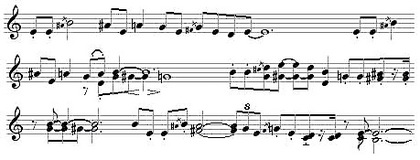Sarah Cahill’s premiere of my War Is Just a Racket last night was fabulous. The video her husband John Sanborn made to accompany my piece (which I hadn’t yet seen), was, I thought, with its footage of General Smedley Butler speaking and a dollar bill waving like a flag, the evening’s most apt and imaginative video, and I’m ready to package the music plus video as a multimedia piece. (It does require three screens, though, which will make the video impractical for general use.)Â
But I’m stuck with one of those nagging problems that plagues composers from time to time: the agony of unintended quotation. There’s a bluesy tune at the end of the piece (E minor/major over an A-flat minor bass line, I just love bitonality) that contains five notes in a row in common with the Gershwin song “It Ain’t Necessarily So,” and too many people are coming up to me to ask, “Why did you quote ‘It Ain’t Necessarily So'”? Here’s the melody:
I wasn’t thinking of the Gershwin song when I wrote it, and it doesn’t come to my mind when I hear the piece. Gershwin’s song is in triple time, it doesn’t start with a double upbeat, and its quintessential feature is a chromatic descent from B down to G, of which I use only B, A#, A, and a repeated G natural. I really, truly, I swear, don’t think of this:
when I hear my piece. As far as I’m concerned, I was channeling a blues idiom that Gershwin was also thinking of in Porgy and Bess – we had a source in common. The worst is the people who ask me, “Have you ever heard ‘It Ain’t Necessarily So’?,” and then hum it for me, as though I hadn’t been able to sing Porgy and Bess all the way from “Summertime” through “I’m on My Way” since I was 13. (I am, after all, the author of a history of 20th-century American music, and had it turned out that I was unfamiliar with Porgy and Bess, a move would have been called for to remainder the book and strip me of tenure.)
Now, since the piece consists of General Butler basically talking about having been deceived by the U.S. military, reference to “It Ain’t” makes a certain sense, so I could just respond to queries with a knowing look and slight arch of the eyebrow. But it comes at what I intended as the most poignant point in the piece (which John replicated in the video as well), and the idea of all those lovely audience members suddenly brightening up and thinking of Gershwin at that delicate moment drives me bananas. As a critic, I tried never to point out resemblances between note patterns in new music and classic tunes, unless some reinforcement or context made it clear that it was intentional. (I broke that rule once in the late 1980s with regard to a Mikel Rouse piece that started coincidentally with the first five notes of “There’s a Place for Us,” and it’s been on my conscience ever since.) As I once rather notoriously quoted Billy Joel saying, “There are only twelve notes, so everything’s going to sound like something, man.” No one should have a de facto copyright on any pitch pattern as small as five notes. But I’m a pragmatist, and all those people are my friends and well-intended, and I think I’m just going to have to change it. Porgy and Bess ain’t going anywhere, fortunately, and I just have to concede that Gershwin got there first and planted his flag on E B A# E A. But I can’t see what to change it to that’s as good. I guess most composers run into this at some time or another – but not Xenakis, I bet. Maybe that’s why serialism had the run it did.Â

